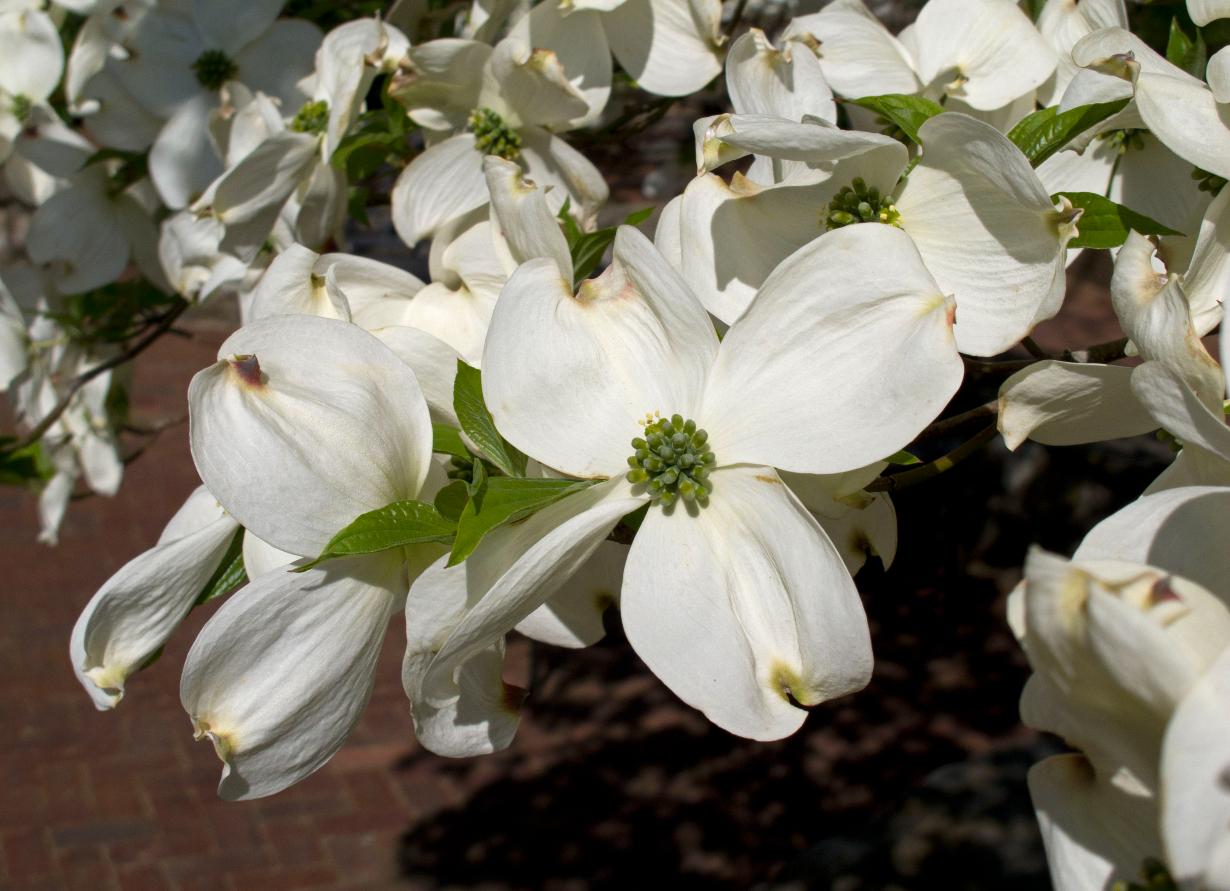Types of Dogwood trees include Pink Dogwood, White Dogwood, and Kousa Dogwood. These trees offer stunning blooms and vibrant foliage.
Dogwood trees are a popular choice for gardens due to their beauty and versatility. The Pink Dogwood (Cornus florida var. Rubra) provides lovely pink blossoms in spring. The White Dogwood (Cornus florida) is known for its classic white flowers. Kousa Dogwood (Cornus kousa) features star-shaped blooms and attractive bark.
Each type brings unique aesthetic appeal and seasonal interest. Dogwoods thrive in various climates and soil conditions, making them ideal for many landscapes. They also attract birds and pollinators, enhancing garden biodiversity. Consider these types for a beautiful and functional garden addition.
Introduction To Dogwood Trees
Dogwood trees are known for their stunning flowers and bright colors. These trees can transform any garden into a beautiful landscape. They offer a mix of white, pink, and red blooms. Each variety has its unique charm and characteristics. Dogwood trees are also famous for their autumn foliage and berries. They provide year-round interest and beauty.
Popular Varieties
Dogwood trees come in several popular varieties. Each has distinct features:
- Flowering Dogwood (Cornus florida): This is the most well-known type. It features white or pink flowers in spring.
- Kousa Dogwood (Cornus kousa): This variety has star-shaped white flowers. It blooms later than the Flowering Dogwood.
- Pacific Dogwood (Cornus nuttallii): It is native to the western United States. It has large white flowers.
- Red Twig Dogwood (Cornus sericea): Known for its red stems in winter. It adds color even without leaves.
Regional Adaptations
Dogwood trees adapt well to various regions. They thrive in different climates:
| Region | Suitable Varieties |
|---|---|
| East Coast | Flowering Dogwood, Kousa Dogwood |
| West Coast | Pacific Dogwood, Red Twig Dogwood |
| Midwest | Flowering Dogwood, Red Twig Dogwood |
| South | Flowering Dogwood, Kousa Dogwood |
Dogwood trees prefer well-drained soil and partial shade. They need regular watering, especially in dry regions. With proper care, they can thrive and provide beauty for many years.
Pink Dogwood Trees
Pink Dogwood Trees are a stunning addition to any garden or landscape. Their vibrant pink blossoms can brighten up any space, making them a popular choice for homeowners and gardeners. Let’s explore the characteristics and ideal growing conditions of these beautiful trees.
Characteristics
Pink Dogwood Trees, also known as Cornus florida ‘Rubra’, are renowned for their striking pink flowers. These flowers bloom in spring and can last for several weeks. The trees usually grow to a height of 15-30 feet, making them suitable for both small and large gardens.
Key characteristics of Pink Dogwood Trees:
- Flowers: Bright pink, blooming in spring.
- Leaves: Dark green in summer, turning red or purple in fall.
- Height: 15-30 feet.
- Spread: 15-30 feet, with a rounded canopy.
- Bark: Gray and smooth, becoming scaly with age.
Ideal Growing Conditions
For optimal growth, Pink Dogwood Trees require specific conditions. These trees thrive in well-drained, acidic soil. They prefer partial shade but can tolerate full sun with adequate moisture.
Ideal growing conditions include:
| Condition | Requirement |
|---|---|
| Soil | Well-drained, acidic |
| Light | Partial shade to full sun |
| Water | Regular watering, especially in dry periods |
| Temperature | Hardy in USDA zones 5-9 |
Planting Pink Dogwood Trees in the right spot ensures healthy growth. Regular watering is crucial, especially during dry spells. Also, mulch around the base to retain moisture and control weeds.
These trees are not only beautiful but also attract wildlife. Birds and butterflies love Pink Dogwood Trees. Adding one to your garden can enhance its beauty and ecological value.
White Dogwood Trees
White Dogwood Trees are one of the most beloved ornamental trees. These trees are known for their stunning white blooms in spring. They offer a striking contrast against their dark green leaves. Their beauty and ease of care make them a favorite choice for gardens and landscapes.
Distinct Features
White Dogwood Trees have several distinct features that set them apart:
- Blooms: White, four-petaled flowers that appear in early spring.
- Leaves: Dark green leaves that turn red in the fall.
- Bark: Smooth, gray bark with a distinctive pattern.
- Height: Typically reaches 15-30 feet tall.
- Spread: Can spread 15-30 feet wide.
Care Tips
Proper care ensures your White Dogwood Tree thrives:
- Location: Plant in a spot with partial shade.
- Soil: Use well-drained, acidic soil.
- Watering: Keep the soil consistently moist, especially in dry periods.
- Mulching: Apply mulch to retain moisture and control weeds.
- Pruning: Prune dead or diseased branches in late winter.
By following these care tips, your White Dogwood Tree will flourish, bringing beauty to your garden for years.
Red Dogwood Trees
Red Dogwood Trees are a striking addition to any garden. Their vibrant red blooms and unique foliage make them stand out. These trees are known for their beauty and versatility. Let’s explore their unique attributes and best planting practices.
Unique Attributes
Red Dogwood Trees boast stunning red flowers in spring. These blooms create a vibrant display. The flowers are followed by glossy, red berries. These berries attract birds and wildlife. In fall, the leaves turn a deep red or purple. This provides a beautiful autumnal show.
- Red Flowers: Bright and eye-catching in spring.
- Red Berries: Attract birds and provide food for wildlife.
- Fall Foliage: Leaves turn deep red or purple.
Best Planting Practices
Plant Red Dogwood Trees in well-drained soil. They prefer a location with full sun to partial shade. Ensure the soil is rich in organic matter. Water regularly, especially during dry spells.
- Choose the right location: Full sun to partial shade.
- Prepare the soil: Well-drained and rich in organic matter.
- Watering: Regularly, especially in dry periods.
Mulching around the base helps retain moisture. It also keeps the roots cool. Prune the tree in late winter. This encourages healthy growth and flowering. Monitor for pests and diseases. Treat them promptly to keep the tree healthy.
| Aspect | Recommendation |
|---|---|
| Location | Full sun to partial shade |
| Soil | Well-drained, rich in organic matter |
| Watering | Regularly, especially during dry spells |
| Mulching | Around the base to retain moisture |
| Pruning | Late winter for healthy growth |
By following these tips, your Red Dogwood Tree will thrive. Its beauty and vibrant colors will enhance your garden.
Yellow Dogwood Trees
Yellow Dogwood Trees are a unique addition to any garden. Their bright yellow stems stand out beautifully in the winter landscape. These trees not only add color but also create a stunning contrast with the snow. Let’s dive into more details about Yellow Dogwood Trees.
Identification
Recognizing Yellow Dogwood Trees is straightforward. They have vibrant yellow stems. During spring, they bloom with small white flowers. Their leaves are green during summer and turn red-purple in autumn.
| Feature | Details |
|---|---|
| Stem Color | Bright Yellow |
| Flowers | Small White |
| Leaves | Green in Summer, Red-Purple in Autumn |
Maintenance Guide
Maintaining Yellow Dogwood Trees is easy. Follow these simple steps:
- Watering: Keep the soil moist but not waterlogged.
- Pruning: Prune in late winter to maintain shape.
- Fertilizing: Use a balanced fertilizer in early spring.
- Pest Control: Watch for aphids and treat if necessary.
- Sunlight: Plant in full sun to partial shade.
By following these steps, your Yellow Dogwood Trees will thrive and bring vibrant color to your garden year-round.

Credit: www.finegardening.com
Hybrid Dogwood Trees
Dogwood trees are beloved for their stunning blossoms and vibrant foliage. Hybrid dogwood trees combine the best traits of different dogwood species. This results in trees that are both beautiful and hardy. Let’s explore hybrid dogwood trees in detail.
Creation And Benefits
Hybrid dogwood trees are created by cross-breeding two different dogwood species. This process aims to enhance specific qualities such as flower color, disease resistance, and growth habits. By combining the best attributes of each parent species, hybrids offer several benefits.
- Enhanced Beauty: Hybrid dogwoods often produce more vibrant and diverse blooms.
- Improved Hardiness: They are more resilient to weather changes and diseases.
- Extended Blooming Season: Some hybrids bloom longer than their parent species.
Common Hybrids
There are several popular hybrid dogwood varieties. Each offers unique features and advantages. Here are a few noteworthy examples:
| Hybrid Name | Parent Species | Key Features |
|---|---|---|
| Cornus Rutban (Aurora Dogwood) | Cornus florida x Cornus kousa | Large white blooms, excellent disease resistance |
| Cornus Stellar Pink | Cornus florida x Cornus kousa | Soft pink flowers, robust growth |
| Cornus Constellation | Cornus florida x Cornus kousa | Prolific white flowers, strong against diseases |
These hybrids are perfect for adding beauty and variety to your garden. They combine the best qualities of their parent species. This makes them a popular choice among gardeners.
Planting And Care
Planting and caring for Dogwood trees, such as Pink and White varieties, is essential for their growth. These trees need specific conditions for optimal health. Below are the key aspects to consider.
Soil Requirements
Dogwood trees thrive in rich, well-drained soil. They prefer slightly acidic soil with a pH level between 5.5 and 6.5. It’s best to avoid heavy clay soil as it retains too much moisture.
| Soil Type | pH Level | Characteristics |
|---|---|---|
| Loamy Soil | 5.5 – 6.5 | Well-drained and nutrient-rich |
| Sandy Soil | 5.5 – 6.5 | Good drainage, but needs organic matter |
| Clay Soil | 5.5 – 6.5 | Poor drainage, needs amendment |
Watering And Fertilizing
Watering is crucial for Dogwood trees. Young trees need deep watering once a week. Mature trees need watering during dry spells.
- Water deeply to reach the roots.
- Use mulch to retain soil moisture.
- Avoid overwatering to prevent root rot.
Fertilizing Dogwood trees keeps them healthy. Apply a balanced, slow-release fertilizer in early spring. Avoid fertilizing late in the growing season.
- Apply fertilizer around the tree’s drip line.
- Use a 10-10-10 or 12-4-8 formula.
- Follow the manufacturer’s instructions for application rates.

Credit: extension.umd.edu
Pests And Diseases
Dogwood trees are a delight in any garden. Their vibrant blooms and foliage add charm. Yet, like any plant, they face pests and diseases. Understanding these issues helps in maintaining their health.
Common Issues
Dogwood trees often face several common problems. These can be pests or diseases. Here are some notable ones:
- Dogwood Borer: This insect invades the tree’s trunk. It weakens the tree and can cause death.
- Powdery Mildew: A fungal disease. It covers leaves with a white powder.
- Anthracnose: Another fungal problem. It causes leaf spots and dieback.
- Leaf Spot: This disease creates dark spots on leaves. It can lead to leaf drop.
Prevention And Treatment
Preventing and treating issues is crucial for dogwood health. Here’s how:
- Proper Watering: Water at the base. Avoid wetting the foliage.
- Pruning: Remove dead or diseased branches. This improves air circulation.
- Fungicides: Use fungicides for fungal infections. Follow the instructions carefully.
- Insecticides: Apply insecticides for pest control. Target the affected areas.
- Cleanliness: Keep the area around the tree clean. Remove fallen leaves and debris.
Below is a table summarizing key pests and diseases, along with their treatments:
| Issue | Symptoms | Treatment |
|---|---|---|
| Dogwood Borer | Trunk damage, weak branches | Insecticides, remove affected wood |
| Powdery Mildew | White powder on leaves | Fungicide, proper watering |
| Anthracnose | Leaf spots, dieback | Fungicide, prune affected branches |
| Leaf Spot | Dark spots on leaves | Remove affected leaves, fungicide |
Landscape Uses
Dogwood trees are popular for their stunning blooms and attractive foliage. They can enhance any landscape with their beauty. Whether you choose pink, white, or other varieties, these trees offer diverse options for different settings.
Design Ideas
Dogwood trees are versatile in landscape design. Here are some ideas:
- Accent Trees: Use them as focal points in your garden.
- Border Trees: Plant them along property lines for a natural border.
- Shade Trees: Their wide canopies provide excellent shade.
- Pathway Liners: Line walkways with dogwoods for a scenic route.
Companion Plants
Dogwood trees pair well with many other plants. Consider these companions:
| Companion Plant | Benefits |
|---|---|
| Azaleas | They thrive in similar soil conditions. |
| Ferns | Provide contrasting foliage texture. |
| Hostas | Offer ground cover and shade tolerance. |
| Rhododendrons | Complement dogwoods with colorful blooms. |
These combinations can create a visually appealing and healthy garden environment.
:max_bytes(150000):strip_icc()/GettyImages-112783738-2000-11889e53b46e4152a9908b1293bc38a8.jpg)
Credit: www.southernliving.com
Frequently Asked Questions
What Are The Different Types Of Dogwood Trees?
The different types of dogwood trees include Flowering Dogwood, Kousa Dogwood, Pacific Dogwood, and Cornelian Cherry Dogwood. Each type offers unique blooms and features, suitable for various landscapes.
What Is The Prettiest Dogwood Tree?
The Flowering Dogwood (Cornus florida) is often considered the prettiest dogwood tree. It features stunning white or pink blossoms.
Are Dogwood Trees Pink Or White?
Dogwood trees can have pink or white flowers. Their vibrant blooms add beauty to landscapes in spring.
How Many Colors Do Dogwood Trees Come In?
Dogwood trees come in four main colors: white, pink, red, and yellow. These vibrant blooms add beauty to landscapes.
Conclusion
Discovering the diverse types of dogwood trees enriches your garden. Pink, white, and other varieties offer unique beauty. Choose the right dogwood tree to enhance your landscape. Enjoy vibrant blooms and lush greenery throughout the seasons. Celebrate nature’s elegance with these stunning trees in your outdoor space.




